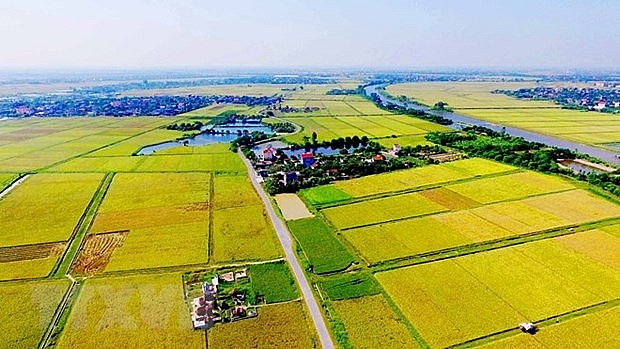Investors face barriers in obtaining agricultural land
 |
| Investors face barriers in obtaining agricultural land - Illustrative image (Source: VNA) |
Nguyen Lam Vien, general director of agricultural product producer Vinamit, said that the company has been looking for land for years in a bid to expand, but has struggled to find anything suitable. “The company has processing facilities from Ca Mau to Lang Son provinces, and the consumers’ demand for products has high potential, thus one of the leading concerns is how to have enough land for production. The problem is that obtaining a big area of land is a challenge,” Vien said.
For example, to secure 30 hectares, the company has to negotiate with 130 landowners. “However, after finishing the negotiations, numerous households changed their minds or asked for changes. Besides that, a lot of farmers take their land out of production but they still do not want to transfer the land use rights to businesses,” he said.
According to Vien, in the southernmost province of An Giang, the company worked with households and authorities to be permitted a 2,000-hectare area. However, after signing the contracts, some households cancelled because they were afraid of losing their land.
Many domestic and foreign-invested enterprises agree that the biggest barrier is the instability in rental land. Groups with investments in high-tech agriculture also face problems about land. Investing in the high-tech agricultural sector needs large land – however, at present, agricultural land holdings in Vietnam are typically small and highly fragmented, especially in the north. Land accumulation in Vietnam is also quite slow and the transfer of land use and lease rights still meet a lot of difficulties.
Statistics published by the Ministry of Agriculture and Rural Development show that at present, Vietnam has over 11 million hectares of agricultural land divided into 78 million land plots and owned by 8.5 million landowners. Only 3.4 per cent of landowners have land plots having an area of over 3ha.
Truong Hung, vice chairman of the Board of Directors of foodstuff producer and agricultural developer Nutifood, told VIR, “The land fund is the key factor for the high-tech agricultural sector, because if the investors lack money, they can arrange different sources. But if they can’t gather enough land they may change their investment strategy compared to the initial plan.”
There is a situation at present in which large agricultural land funds are being used ineffectively, but investors still cannot approach the land due to strict legal regulations. “In reality, large-scale investors will have advantages in collecting land, but the problem is that almost all businesses in agriculture are smaller in size,” Hung added.
Elsewhere, Hokuto Corporation was established over 50 years and has dozens of mushroom production factories in the United States, Taiwan, and Malaysia with a distribution network in Japan, the US, and Europe. However, when it looked at investing in Vietnam, land was by far the biggest hurdle.
According to Nguyen Dinh Nam, founder and CEO of investment consultancy IPA Vietnam, the unit working on Hokuto’s investment plan in Vietnam, the corporation was to fund a high-tech mushroom production factory in a Southeast Asian country under the direct investment model. But after deadlocks on land and legal issues, they decided to cooperate with a domestic company named Construction Application and Transfer of Technologies JSC to take care of the work. In this deal, Hokuto only needs to pour capital and transfer the technology.
In view of the difficulties, many foreign investors have decided to change their investment method from direct funding to a paid-in capital investment strategy. Meanwhile, some domestic businesses have also decided to invest elsewhere instead, such as in Laos and Cambodia.
According to agricultural corporation HAGL, in Vietnam it could not find a land plot big enough for growing sugar cane, oil palm and corn. However, in Laos, it was not a challenge and they collected approximately 35,000ha. Thus, they were forced to invest billions of US dollars in this country instead of Vietnam.
“To promote the development of high-tech agriculture, the decisive factor is the adjustment of policy. Notably, the government, the prime minister, and other ministries and sectors at the central level are required to consider and propose the National Assembly to amend and supplement the Law on Land 2013 soon,” Hung of Nutifood said.
According to the Ministry of Planning and Investment, as of April 20, Vietnam had 520 agro-forestry-fishery projects registered at $3.74 billion, or merely 0.9 per cent of Vietnam’s total registered foreign direct investment. In January-April 20, Vietnam wooed only eight projects with newly registered capital, stake acquisitions, and paid-in capital, worth a total of $17 million.
What the stars mean:
★ Poor ★ ★ Promising ★★★ Good ★★★★ Very good ★★★★★ Exceptional
Related Contents
Latest News
More News
- Global partnerships key to Vietnam’s IFC development (December 26, 2025 | 16:18)
- Vingroup pulls out of bid to invest in North-South high-speed railway (December 26, 2025 | 11:42)
- Strengthening supply chains through trade promotions and customs reform (December 24, 2025 | 14:00)
- PM orders investment model for North–South high-speed rail (December 22, 2025 | 17:43)
- LS Eco Energy to invest in Vietnam rare earth sector (December 22, 2025 | 17:31)
- Government moves to establish International Financial Centre (December 21, 2025 | 21:00)
- Vietnam's IFC to target global investment flows (December 21, 2025 | 18:00)
- Two national hospitals expand capacity with new facilities (December 20, 2025 | 09:00)
- Ha Tinh breaks ground on major Vingroup industrial and energy projects (December 19, 2025 | 18:24)
- EVN launches major power infrastructure projects nationwide (December 19, 2025 | 18:17)

 Tag:
Tag:





















 Mobile Version
Mobile Version